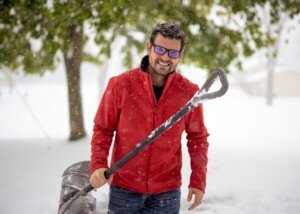
Find out why it’s a mistake to think that shoveling snow replaces your scheduled cardio or strength training workout for the day.
Shoveling snow elevates heart rate and makes one breathe faster, and the more out of shape someone is, the more pronounced these effects are; this makes shoveling snow sound like a form of cardio exercise. I’m a personal trainer.
It gets the heart rate up, yes, and even though the physical activity is non-rhythmic and tends to be done mostly with one’s dominant side, shoveling snow actually qualifies as a cardio workout.
There are a few variables to consider.
If your normal cardio workout consists of high intensity interval training (HIIT), your structured cardio session is more intense than the cardio output you’d be executing when shoveling snow.
Therefore, if your high intensity interval training session is scheduled the same day you shovel snow, I’d say do the HIIT first.
Consider the snow shoveling a chore that needs to be done and an opportunity to burn some extra calories so that you can enjoy a second piece of pie after dinner.
If you normally do nonstop (steady state) cardio, then consider that shoveling snow is not a good replacement, since this chore is of a stop and go nature
Often, people will rest for several minutes, just standing in the driveway looking about, before resuming the work.
This does not mimic steady state cardio, and if you prefer steady state, then don’t skip your planned steady state session.
Shoveling snow much more closely mimics HIIT, due to its stop and go nature.
If you’re used to HIIT, then you can mimic this by shoveling like a demon for about 30 seconds, then marching in place for a few minutes for recovery.
Don’t forget, though, that no matter how fit you are in terms of HIIT, shoveling snow is a weight-bearing activity that, when performed with a “lift with the legs” approach, combines semi-squatting motions with shoulder, chest, biceps and lower back work.
There is also some lighter rowing motions involved, when repositioning the shovel.
The semi-squatting refers to a partial squat or very bent knees, to allow the legs to absorb most of the forces rather than make the lower back do so.
Nevertheless, you’ll still end up using the lower back.
In summary, this chore can be substituted for high intensity cardio sessions if the physical exertion of the HIIT work intervals is comparable to the snow shoveling intervals.
 Lorra Garrick is a former personal trainer certified through the American Council on Exercise. At Bally Total Fitness she trained women and men of all ages for fat loss, muscle building, fitness and improved health.
Lorra Garrick is a former personal trainer certified through the American Council on Exercise. At Bally Total Fitness she trained women and men of all ages for fat loss, muscle building, fitness and improved health.
.


























